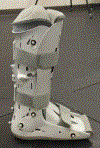Effects of a corrective heel lift with an orthopaedic walking boot on joint mechanics and symmetry during gait
- PMID: 31376749
- PMCID: PMC6719687
- DOI: 10.1016/j.gaitpost.2019.07.374
Effects of a corrective heel lift with an orthopaedic walking boot on joint mechanics and symmetry during gait
Abstract
Background: Orthopaedic walking boots are commonly prescribed following injury and surgery. The boot creates a leg length discrepancy which is thought to affect limb symmetry and gait mechanics. This study aimed to examine the effects of a corrective heel lift for the contralateral limb on the mechanics and symmetry of walking with an orthopaedic walking boot.
Research question: Does a corrective heel lift reduce biomechanical alterations and asymmetries caused by an orthopaedic boot during gait?
Methods: Healthy males (n=17) walked with normal shoes (Shod), an orthopaedic boot (Boot), and a corrective heel lift on the contralateral limb to the boot (Lift). A 10-camera motion capture system (Vicon, 100Hz) and four force platforms (AMTI, 1000 Hz) recorded lower extremity biomechanics. Pairwise statistics tested for differences in hip and knee kinematics and kinetics, and a symmetry index quantified limb symmetry.
Findings: The Boot affected the sagittal and frontal plane hip mechanics and transverse plane knee mechanics (p<0.05), and increased the asymmetry compared to the Shod condition. The Lift improved the symmetry of some measures but increased the frontal plane hip asymmetry compared to the Boot. However, introducing the Lift did not change all kinematic variables affected by the boot.
Significance: The Lift reduced some of the asymmetries introduced by the Boot, but also introduced new asymmetry in the hip frontal plane motion. The leg length discrepancy caused by the boot is probably not the only cause of altered gait mechanics. Prescribing a heel lift to a patient with an orthopaedic walking boot should be based on the individual patient's needs.
Keywords: Biomechanics; Brace; Gait; Orthopedics; Rehabilitation.
Copyright © 2019 Elsevier B.V. All rights reserved.
Conflict of interest statement
6. Conflict of interest
The authors declare no conflict of interest
Figures




Similar articles
-
3D gait analysis with and without an orthopedic walking boot.Gait Posture. 2018 Jan;59:76-82. doi: 10.1016/j.gaitpost.2017.09.024. Epub 2017 Oct 5. Gait Posture. 2018. PMID: 29020659
-
Acute biomechanical responses to wearing a controlled ankle motion (CAM) Walker boot during walking.Gait Posture. 2024 Feb;108:208-214. doi: 10.1016/j.gaitpost.2023.12.011. Epub 2023 Dec 17. Gait Posture. 2024. PMID: 38118224
-
Biomechanical implications of the negative heel rocker sole shoe: gait kinematics and kinetics.Gait Posture. 2006 Nov;24(3):323-30. doi: 10.1016/j.gaitpost.2005.10.006. Epub 2005 Nov 21. Gait Posture. 2006. PMID: 16300949
-
Contributions to the understanding of gait control.Dan Med J. 2014 Apr;61(4):B4823. Dan Med J. 2014. PMID: 24814597 Review.
-
Increased knee flexion and varus moments during gait with high-heeled shoes: A systematic review and meta-analysis.Gait Posture. 2021 Mar;85:117-125. doi: 10.1016/j.gaitpost.2021.01.017. Epub 2021 Jan 21. Gait Posture. 2021. PMID: 33548909
Cited by
-
Measurement of plantar pressure differences in the contralateral limb when using offloading modalities for diabetic foot ulcerations.J Foot Ankle Res. 2025 Mar;18(1):e70028. doi: 10.1002/jfa2.70028. J Foot Ankle Res. 2025. PMID: 39797703 Free PMC article. Clinical Trial.
-
A Comprehensive Review of Vision-Based Sensor Systems for Human Gait Analysis.Sensors (Basel). 2025 Jan 16;25(2):498. doi: 10.3390/s25020498. Sensors (Basel). 2025. PMID: 39860869 Free PMC article. Review.
-
Gait symmetry - A valid parameter for pre and post planning for total knee arthroplasty.J Musculoskelet Neuronal Interact. 2022 Mar 1;22(1):102-112. J Musculoskelet Neuronal Interact. 2022. PMID: 35234165 Free PMC article.
-
Pedobarographic evaluation of five commonly used orthoses for the lower extremity.Arch Orthop Trauma Surg. 2023 Jul;143(7):4249-4256. doi: 10.1007/s00402-022-04729-2. Epub 2022 Dec 26. Arch Orthop Trauma Surg. 2023. PMID: 36571629 Free PMC article.
-
Effect of Leg Length-Evening Device on Perceived Balance in Patients Wearing a Controlled Ankle Motion Boot.Foot Ankle Orthop. 2020 Jul 28;5(3):2473011420930236. doi: 10.1177/2473011420930236. eCollection 2020 Jul. Foot Ankle Orthop. 2020. PMID: 35097386 Free PMC article.
References
Publication types
MeSH terms
Grants and funding
LinkOut - more resources
Full Text Sources

